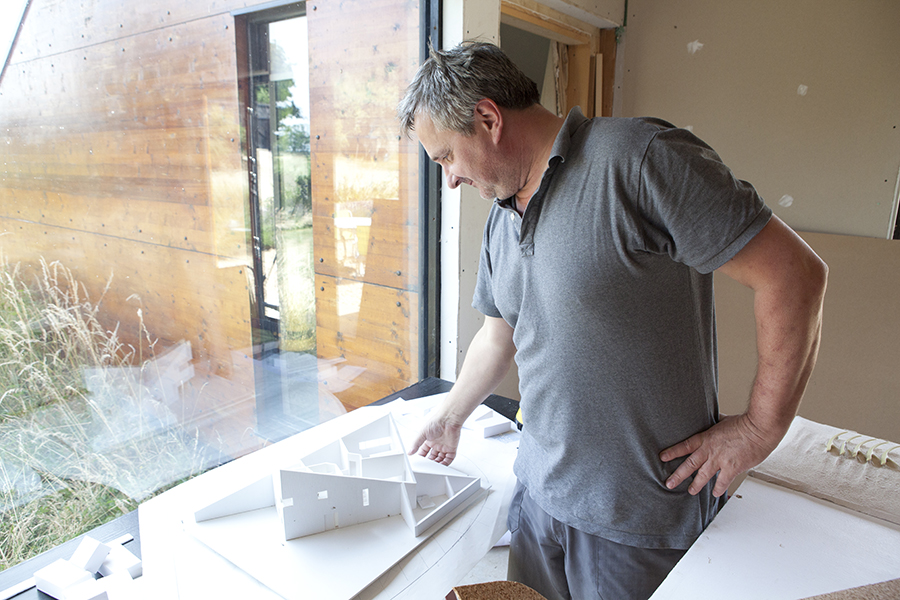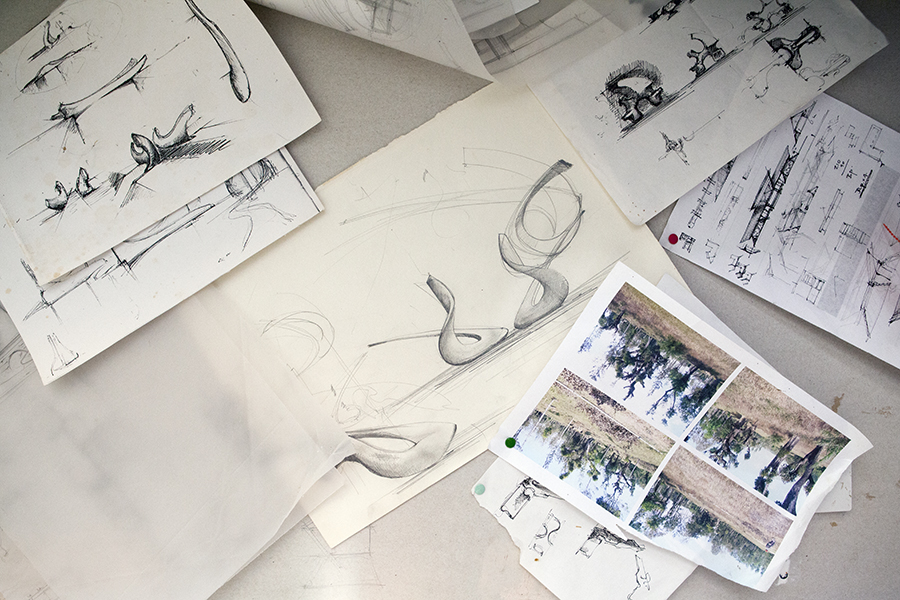Architecting A Lifestyle
Interview & Photographs by Jameson Kergozou
Hidden away in the hills of Somerset lies Welham Studio, a wondrous union of architecture and it’s surroundings. Welhem Studio’s architect and inhabitant is Mark Merer. The studio is the result of an earlier landhouse project designed working with the Swinomish Indian Tribal Community of Fidalgo Island in Washington State. It’s design takes full advantage of green features including a meadow roof, which allows a safe environment for birds and insects to live, whilst also being beneficial to the inhabitants; a cooling effect during hot periods and rain absorbtion prolongs the life of the roofing material.
Mark works in many 3 dimensional fields: Architect, Sculptor and land artist to name a few but he actually started out working on building sites learning many trades after leaving school. At the age of 27 he decided to go back into college studying painting at the Bower Ashton campus in Bristol where he discovered the American land artist such as Smithson and later the British landscape artists Long and Goldsworthy “which I sat somewhere in between in my head.” And left painting and the two-dimensional world behind.
Coming from a hands on experience was that a big influence on your work early on?
Massive yeah, fundamentally for me it was more about finding out about one’s self. It’s as much about self-discovery as learning one’s trade. The old man was very keen, he was like get out there and get on with it. He believed you had to do it yourself. So I learned that it was quite nice to do a bit of physical work and I found that I was a lot more comfortable in a three dimensional world.
When did you first move to Somerset and what was so appealing about the area?
It’s cheap, ha ha. No, I went to college and met my wife, we got married and we moved to just outside of Bath. She is local so I sort of married in really, we found a great studio which was the real catalyst, I mean we were looking at America and lots of places we could have gone but this studio came up in Nunney of all places but it was just this massive old place which was an old dog food factory but it was just really cheap so the decision was very work orientated and I just got quite into it.
What are some of your favourite places in the area?
The Somerset levels are beginning to ring bells, there’s something very special about them and that’s just the landscape number. Looking over the levels and you see the bumps and the humps, I find that really exciting especially when you imagine the water and you think about what it used to look like and then it must have been really magical, there’s a lot of history and you can really feel it here.
I love landscape in that fashion but that could be anywhere but some landscape does feel ancient and I can’t help thinking that we were much more connected.
You have worked with quantum physicists in the past, how do you take in that obviously complicated information and use it?
Because I come from the art world the process of working of drawing in, especially when it comes to the more public realm where you’re dealing with spaces communities and that sort of thing it’s always been about collecting as much as you can from all the other areas and I treat the personal work in the same way. Its just about information gathering whether it’s information gathering from a scientific point of view which I mind blowing enormous as it is from a more spiritual side of things which has also got lots of different connections in the same way its site specific to the life.
The landhouse project and the Welham studio here are both very environmentally sensitive, has living in the countryside influenced that?
Well I’ve always been quite keen on the environmental side of things. That’s always been quite strong. It’s always seemed like common sense. Living in the countryside now what has become very apparent, is how we treat the landscape like a factory and I find that it’s almost lost the romance in that shallow way, but the landscape always influences because it’s the source material for me. You see constant examples everyday how things interact with each other, the awfulness and the cruelty all that side of it.
Then also in a way you see one’s existence in it, it’s slightly easier to try and step back from it. Because you are seeing yourself in all this other life and if you are in the city and as much as I love that too it’s much more about the jungle but not in the same way.
Your work takes you to India a lot, what are some of your favourite things about the subcontinent?
I feel very at home there having grown up in Malaysia. India is just immense, you’ve got the whole of humanity in front of you from one end to the other, it’s just the extremes and I feel like it’s much more like how the world is like. You see a whole lot more of humanity it’s just so beautiful but so cruel and vicious.
I’ve been going once a year for the last 10- 12 years for about a month or so at a time depending on the project. I love it also because Bangalore which is where I am based and mainly go, I think was at one point the fastest growing city in Asia and it is just horrific to watch, almost unbelievable to see this enormous expansion with so little regard for what is actually being done let alone design but the energy is just phenomenal and that’s fascinating to watch its just exploding and also exciting to be there cause you feel you could really do something there in terms of contributing to the idea of green or the idea of being responsible it’s not just about how much you can get in your pocket and leave the people in the ditch sort of thing. You feel you can contribute a bit more there, which at the same time is very uplifting.
You work under many different trades is there one you would pick?
To me I don’t see any difference it’s just three dimensional, for me sculpture is just the 3 dimensional language or rather it’s the manipulation of it or the playing with it in some format everything comes into the 3 dimensional language whether one’s messing around with roads it should have an aspect of aesthetic appreciation put into it.
Can you talk about the work your doing with clay and some of your other current projects?
I love the idea of using the elements to combine with how one may solve certain problems or just see how things react and form. If you look at a pebble on the beach, over the time the shapes in form the other shapes with the influence of the elements, wind rain, tides so if simplified this idea using objects that I want to use or forms that relate to one area bunging it into clay and letting the rain wash or letting them crack and dry out is part of the exploration if you like and it informs how we can place or how one might deal with an area using that component it’s just part of the information gathering and you get some wonderful things going on.











